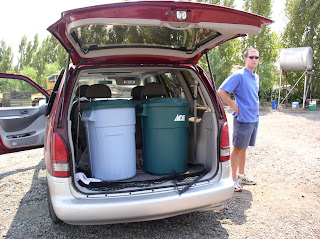I mentioned on my last post that I was going to write about the costs involved in making your own wine. Understanding the costs involved is important for clarifing your reasons for starting this hobby. Think you are going to save money, think again!...
Below is the cost breakdown for two of the wines I'm making this year, the Nebbiolo and the Sauvignon Blanc. I'm going to divide the costs into three sections for reasons that I hope to make clear... Also I'm using current prices as quoted on my favorite wine making supply store.
1. "fixed" cost per bottle
2. Cost of the grapes
3. Equipment
1. "Fixed" cost per bottle
These are "fixed" costs since they typically do not change with the variety of the wine I'm making, e.g. a $1.25 cost per glass bottle does not change depending on the wine put into it.
| Wine Bottle | $1.25 | Yes I recycle, but need to buy also. Some times it's worth buying 2 buck chuck just for the glass! |
| Corks | $.23 | I use 1 3/4" Agglomerated corks...e.g. easy to work with, good compromise between quality and price. |
| Label | $.25 | an estimate of paper and Ink costs. I print my own labels on self stick label stock 4 per page |
| Chemicals | $.40 | Yeast, ML culture, Potassium Metabisulfate, yeast food, etc. |
| Cap | $.10 | These are the metalic heat shrink capsules. Probably the lowest cost cap... I use wax and also plastic slip on when I can find them . |
| Total per bottle | $2.23 | So already it's more expensive than 2 buck chuck! |
2. Cost of the grapes....
| Nebbiolo | $2.60 per bottle | $.75/lb x 250 lb = $ 187.50 yield @ 6 cases |
| Sauvignon Blanc | $1.88 | $180 for 22 gallons yield @ 8 cases |
3. Equipment: I think it's best to look at the equipment costs as a startup or investiment cost and then perhaps a yearly replacement or maintenance cost.
So for startup costs for a typical 6 case {250lbs of grapes} I think you'll need:
Cusher/destemmer -- probably don't need one, most grape suppliers will crush for you at grape pickup time.
Press: you need one, or at least be able to rent one: new #35 press --$435 This is the press I have, and I expect to be the only press I'll ever need. Rentals run about $35 a day.
Siphon hoses, rubber stoppers, fermentation locks, glass carboys, Hydrometer = @ $110
Wine Pump: not needed but recommended... I use a siphon hose to move all my wine around. However, to do this I have to be able to lift carboys up onto a counter to get the siphon to flow {heavy, arkward...}... you should consider a pump. Low end cost @ $140
Bottle Filler: for bottling less than 15 cases at a time, use an inexpensive filler tube = $4
Bottle Corker: You should have your own. While you could get by with a $25 hand corker, I recommend the Italian Floor corker at $125. It will last a lifetime.
So I would say it takes about $415 to get started if you rent a press... Of course if you can borrow or share some of the equipment, costs will go down. Also you could skip some recommend equipment or go low end until you are convinced this is the hobby for you.
Yearly replacement or maintenance costs: I make about 60 gallons a year, and find that I typically spend anywhere from $20-$50 for more minor equipment, e.g. stoppers, fermentation locks, etc.
What's it all mean...... It means that my Nebbiolo costs me $4.83 a bottle to produce, not counting equipment costs, time, car wear and tear and gasoline.
The Sauvignon blanc cost less at $4.03 a bottle.
Are these costs typical? If anything, I'd say they are on the low side, due to great deals on the grapes.
Since there are plenty of good wines out there to be had for under$7.00 a bottle, you have to be making very good wine to beat the cost of buying retail.
I've made a few wines that I think would justify a $20 bottle price, but my typical wine costing me @ $5.00 to produce could be had retail for about the same price with careful shopping.....throw in equipment and time and you're losing money!

So why make wine? It's a hobby! You do it because you enjoy it! The making of wine, learning about wine, sharing your wine with friends, the bottling parties! and of course drinking wine!
















